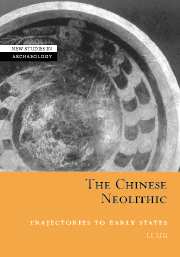Book contents
- Frontmatter
- Contents
- List of illustrations
- List of tables
- Preface
- Cambridge Cultural Social Studies
- 1 Setting the scene
- 2 The changing environmental contexts of China's first complex societies
- 3 Household subsistence and ritual
- 4 Spatial organization and social relations in communities
- 5 Community burial patterns
- 6 Development and decline of complex societies in the Central Plains
- 7 Development and decline of social complexity beyond the Central Plains
- 8 Trajectories toward early states
- 9 Reconstructing social processes
- Notes
- Appendixes
- References
- Index
4 - Spatial organization and social relations in communities
Published online by Cambridge University Press: 22 September 2009
- Frontmatter
- Contents
- List of illustrations
- List of tables
- Preface
- Cambridge Cultural Social Studies
- 1 Setting the scene
- 2 The changing environmental contexts of China's first complex societies
- 3 Household subsistence and ritual
- 4 Spatial organization and social relations in communities
- 5 Community burial patterns
- 6 Development and decline of complex societies in the Central Plains
- 7 Development and decline of social complexity beyond the Central Plains
- 8 Trajectories toward early states
- 9 Reconstructing social processes
- Notes
- Appendixes
- References
- Index
Summary
In one year residences may grow into a settlement, in two years they may form a town, and in three years they may become a city.
“Wudi benji” in Shiji, by Sima Qian, ca. 100 BCIntroduction
Shifting focus from the household to the community, this chapter examines social forms at the intra-settlement level during the Neolithic period. I will discuss changes in architectural forms and settlement layout, and how these spatial patterns were related to social organization and mechanisms.
The spatial structure of a settlement is not only regulated by the physical requirements of effort expenditure, but also by the need to consistently distinguish between different categories of activity and between people of different social status. In other words, a human community has to define boundaries separating the different portions of the settlement, and relate to the orders of nature and culture within the community (Fletcher 1977: 48–55). These relationships should be reflected in the arrangement of community structures, which may be observed archaeologically. It has long been recognized that spatial relationships among archaeological features and artifacts within a settlement can provide important information about the social and economic patterns of a given community (Chang 1968; Deetz 1968; Hodder 1979; Trigger 1968).
Modeling the spatial patterns of residential areas has also been a major concern in studies of complex societies.
- Type
- Chapter
- Information
- The Chinese NeolithicTrajectories to Early States, pp. 73 - 116Publisher: Cambridge University PressPrint publication year: 2005



